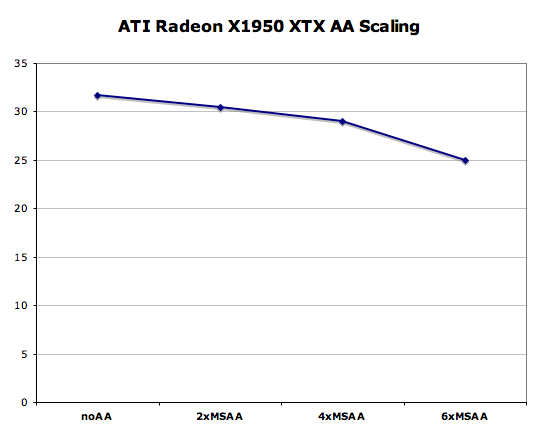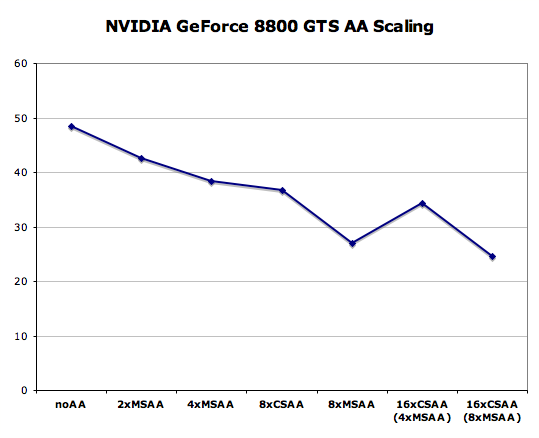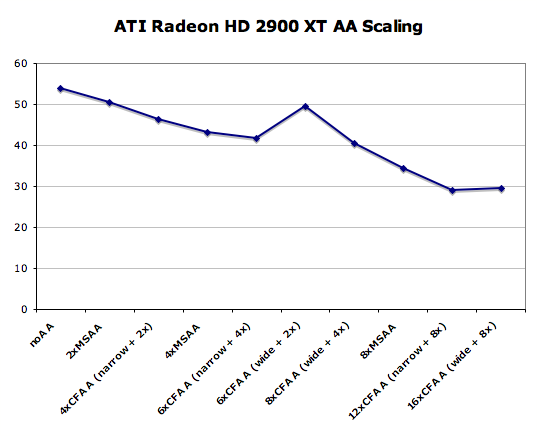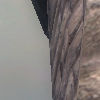ATI Radeon HD 2900 XT: Calling a Spade a Spade
by Derek Wilson on May 14, 2007 12:04 PM EST- Posted in
- GPUs
AMD CFAA Performance and Image Quality
While we've already talked about CFAA, let's take a look at how it compares to other AA methods. We've already seen NVIDIA's CSAA in action, which is able to better determine how subsample colors should be weighted within a pixel. How does it stack up to AMD's tent filters? Let's take a look:
Zip file of uncropped JPG images (1.7MB)
Clearly CFAA does do a good job at reducing the impact of high contrast edges. As we mentioned before though, this doesn't come without drawbacks. Antialiasing shouldn't just filter out high frequency image data (which comes in the form of high contrast edges). The problem lies in the fact that some of these edges are supposed to be there.
Applying a blur to everything isn't the best general purpose answer. Ideally we want to balance eliminating high frequency data we don't want (aliased edges) while preserving the high frequency data we do want (fine grained detail in either geometry or interior textures). A balance needs to be kept here, and (as we've seen many times in the past) the answer for the end user can often be subjective.
This is certainly an interesting solution, but we will stick with simple 4x box filtered MSAA for our current and future tests as it still offers the best balance between image quality and performance - especially at very small pixel sizes. But before we leave the subject completely, let's take a look at how CFAA performs on R600. We'll compare it to all the non-transparent texture aware AA modes available on the X1950 XTX and 8800 GTS 640MB.
















86 Comments
View All Comments
yyrkoon - Tuesday, May 15, 2007 - link
See, the problem here is: guys like you are so bent on saving that little bit of money, by buying a lesser brand name, that you do not even take the time to research your hardware. USe newegg , and read the user reviews, and if that is not enough for you, go to the countless other resources all over the internet.yyrkoon - Tuesday, May 15, 2007 - link
Blame the crappy OEM you bought the card from, not nVIdia. Get an EVGA card, and embrace a completely different aspect on video card life.MSI may make some decent motherboards, but their other components have serious issues.
LoneWolf15 - Thursday, May 17, 2007 - link
Um, since 95% of nvidia-GPU cards on the market are the reference design, I'd say your argument here is shaky at best. EVGA and MSI both use the reference design, and it's even possible that cards with the same GPU came off the same production line at the same plant.DerekWilson - Thursday, May 17, 2007 - link
it is true that the majority of parts are based on reference designs, but that doesn't mean they all come from the same place. I'm sure some of them do, but to say that all of these guys just buy completed boards and put their name on them all the time is selling them a little short.at the same time, the whole argument of which manufacturer builds the better board on a board component level isn't something we can really answer.
what we would suggest is that its better to buy from OEMs who have good customer service and long extensive warranties. this way, even if things do go wrong, there is some recourse for customers who get bad boards or have bad experiences with drivers and software.
cmdrdredd - Monday, May 14, 2007 - link
you're wrong. 99% of people buying these high end cards are gaming. Those gamers demand and deserve the best possible performance. If a card that uses MORE power and costs MORE (x2900xt vs 8800gts) and performs generally the same or slower what is the point? Fact is...ATI's high end is in fact slower than mid range offerings from Nvidia and consumes alot more power. Regardless of what you think, people are buying these based on performance benchmarks in 99% of all cases.AnnonymousCoward - Tuesday, May 15, 2007 - link
No, you're wrong. Did you overlook the emphasis he put on "NOT ALWAYS"?You said 99% use for gaming--so there's 1%. Out of the gamers, many really want LCD scaling to work, so that games aren't stretched horribly on widescreen monitors. Some gamers would also like TVout to work.
So he was right: faster is NOT ALWAYS better.
erwos - Monday, May 14, 2007 - link
It'd be nice to get the scoop on the video decode acceleration present on these boards, and how it stocks up to the (excellent) PureVideo HD found in the 8600 series.imaheadcase - Tuesday, May 15, 2007 - link
I agree! They need to do a whole article on video acceleration on a range of cards and show the pluses and cons of each card in respective areas. A lot of people like myself like to watch videos and game on cards, but like the option open to use the advanced video features.Turnip - Monday, May 14, 2007 - link
"We certainly hope we won't see a repeat of the R600 launch when Barcelona and Agena take on Core 2 Duo/Quad in a few months...."Why, that's exactly what I had been thinking :)
Phew! I made it through the whole thing though, I even read all of those awfully big words and everything! :)
Thanks guys, another top review :)
Kougar - Monday, May 14, 2007 - link
First, great article! I will be going back to reread the very indepth analysis of the hardware and features, something that keeps me a avid Anandtech reader. :)Since it was mentioned that overclocking will be included in a future article, I would like to suggest that if possible watercooling be factored into it. So far one review site has already done a watercooled test with a low-end watercooling setup, and without mods acheived 930MHz on the Core, which indirectly means 930MHz shaders if I understand the hardware.
I'm sure I am not the only reader extremely interested to see if all R600 needs is a ~900-950MHz overclock to offer some solid GTX level performance... or if it would even help at all. Again thanks for the consideration, and the great article! Now off to find some Folding@Home numbers...